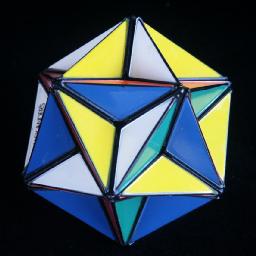


This puzzle is in the shape of a great dodecahedron, which is one of the Kepler-Poinsot polyhedra. As a puzzle it has 12 vertices which are the axes of rotation. There are 30 moving pieces which have two colours each. Each piece forms the edge between two vertices, and five such edges join at each vertex. The great dodecahedron has 12 pentagonal faces, but as these go through the interior of the solid, only part of each pentagon is visible from the outside. The visible part of a pentagon consists of a ring of five triangles. Each ring must be all of one colour, and rings on opposite sides of the puzzle must be the same colour.
This puzzle is equivalent to just the edges of the megaminx. There is however one minor difficulty with the star because only six colours are used and therefore each colour combination occurs twice.
It is not terribly difficult to solve, but this puzzle is infamously hard to twist. It was invented by Adam Alexander, a US mathematician, who patented it on 26 March 1985, US 4,506,891.
This leaves 29!·213 = 72,431,714,252,715,638,411,621,302,272,000,000 or 7.2·1034 positions. There are however 12 solved positions because there are 24 ways of arranging 5 colours around a star if you discount rotations, and two of those occur in each solution.
Let F, R, D be three adjacent vertices (Front, Right and Down), in other words, F, R, D are arranged clockwise at the vertices of a triangle of edges. Let U (Up) be the other vertex adjacent to both F and R, and let L (Left) be the other vertex adjacent to F and D. Clockwise 1/5 twists of a vertex are denoted by the appropriate letter, anti-clockwise 1/5 twists by F', R', L', D' or U'. In the solution below, the D vertex is usually still unsolved.
This puzzle is related to the Megaminx, as it is equivalent to solving only the edges of that puzzle.
| DF->FR: | R'D R |
| DR->RF: | F D'F' |
| DR->DF->DL->DR: | R D R' D R D'D' R' |
| DR->DL->DF->DR: | R DD R' D' R D' R' |
| DR->DF->DB->DR: | R D R' DD R DD R' |
| DR->DB->DF->DR: | R D'D' R' D'D' R D' R' |
| DR-DB, DF-DL: | R D R' D R D' R' DD R DD R' |
| Flip DF, DR: | R D' F D F' D R' D' |
| Flip DL, DR: | R D' F DD F' D R' D'D' |